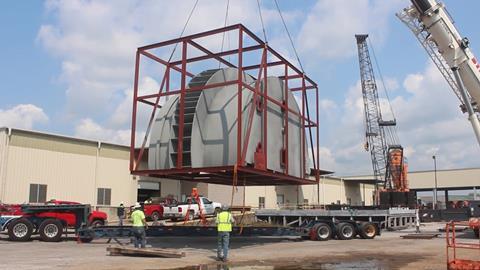Houston-based freight forwarder UTC has coordinated the delivery of 100,000 freight tons of cargo for the expansion of one of the largest cement plants in Mitchell, USA.

Many of the components were over 25 ft (7.6 m) in height and sourced from a range of countries including China, India, Germany, Italy, Romania, Turkey, Egypt, and Mexico.
The largest components were shipped on charter vessels from the ports of Shanghai and Tianjin, China to the port of New Orleans (Port NOLA). Covid-19 restrictions, which are still largely in place across Asia today, led to port congestion, labour shortages and a limitation of raw materials. However, UTC was able to rely on its relationship with other carriers to overcome the issues by securing space on vessels and delaying shipment dates when necessary.
UTC teams across the world had to re-evaluate and find alternative options when cargo originating in Chennai, India, was required urgently. Environmental challenges such as the monsoon in India forced UTC to truck important components in a time and cost effective way from Chennai to Mumbai where the cargo was loaded onto four ro-ro vessels.
Other out-of-gauge items were shipped from Europe by breakbulk vessels and airfreight. 150 truckloads of accessories and parts were transported from Mexico, and UTC provided Customs clearance at the border.
37 chartered hopper barges transported the cargo to the port of Jeffersonville after being discharged in the USA. Once again, UTC prepared for inclement weather, port congestion and delays in the supply chain. With such uncertainties, UTC delivered parts as soon as they were obtainable, storing them in ports as opposed to delivering in sequence.
Last-mile route options for the 24-month project were consulted with Indiana Department of Transportation (INDOT) resulting in an accepted 72 mile (116 km) route suitable for avoiding any interference with local communities and wildlife. UTC entered a USD4 million bond with INDOT allowing site revisions and travel route modifications to accommodate oversized cargo.
Cargo over 18 ft (5.4 m) in height was required to be moved overnight. The largest pieces came in steel crating to facilitate loading and provide protection. However, the crating turned tapered pieces into square cargo, which needed significantly more overhead clearance. By cutting and removing top portions of the crating, several items were transported without stretching utility lines or removing overhanging obstacles. These were trucked using specialised trailers that provided additional height clearance due to their very low base. They moved in convoys of two or three loads to further minimise movement of utility lines and obstacles.
















